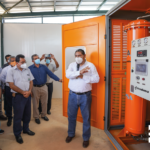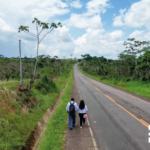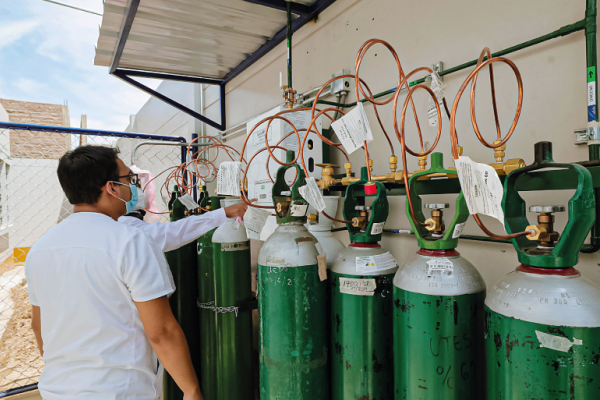With the emergence and spread of COVID-19 worldwide, guaranteeing equitable access to health services and health products has become a constant challenge. Even more so in countries that lack strong, sustainable health systems, such as Peru, which, despite governmental efforts to increase human resource, infrastructure, medical equipment and supplies, and spaces to combat COVID-19, they are not enough.
In recent months, as the number of confirmed COVID-19 cases has been on the rise, the demand for oxygen has increased by more than 300% compared to pre-pandemic oxygen consumption- a key element used for treating patients with coronavirus, pneumonia, respiratory distress syndrome, hypoxemia, among others, according to the World Health Organization (WHO).
«If body cells do not have enough oxygen necessary for its proper functioning, the human body begins to destabilize, causing multiple-organ failure in the patient, resulting in death»
— Dr Marco Tovar, Medical Director of Partners in Health.

At this point, almost two years since the public health emergency declaration, health facilities should be adequately equipped. However, reality indicates the opposite.
In order to continue strengthening the oxygen therapy capacity in primary care health facilities and provide a sustainable response to COVID-19, Partners in Health has toured various hospital and health center facilities in Loreto, Madre de Dios, Ica, Piura, Tumbes, Lambayeque, Trujillo, San Martín, among others. This is to assess the need for installing oxygen units, Manifold panels and oxygen plants for oxygen cylinders or thermoses in COVID-19 zones.
It’s barely 6:00 a.m. and the multidisciplinary team of Partners in Health is ready to travel on the road for more than 16 hours to arrive at the San Martin de Porres Health Center, Iberia, located in Madre de Dios- a Peruvian Amazon region filled with as much natural beauty as its shortcomings in health care access.
«The capacity to care for patients who require oxygen in a health center is limited. In other words, there are no safe treatment sites, so they are forced to go to a more developed hospital»
— Raquel Zamora, Administrative Professional with Partners in Health.
Globally, challenges in the production and distribution of medical oxygen are both financial and logistical. The lack of technology for air concentration, as well as the technical expertise to maintain and operate equipment, require training to ensure a sustainable response to COVID-19.

Installation of oxygen treatment units, panels and plants nationwide
To curb the impact and mitigate the effects of COVID-19, demands not only the effort of the Peruvian state, but also all national and international cooperation possible. It is for this reason that Partners in Health, in collaboration with the United States Agency for International Development (USAID), installed 244 oxygen units. Its aim- strengthening the Peruvian health system’s patient care and access to medicinal oxygen, and improving hospital response in: Hospital Cayetano Heredia, Hipolito Unanue, Sergio E. Bernales, Hospital Referential de Ferreñafe, Hospital Regional de Ica, Hospital Bellavista del Gobierno Regional de San Martín, Hospital Belén de Trujilllo and Ventanilla del Callao.
Subsequently, in order to strengthen primary care and increase oxygen therapy access for cases of moderate hypoxemia, Manifold cylinder panels or oxygen thermoses were installed with their respective distribution systems and oxygen units in regions such as: Loreto (Nanay Health Center, Moronacocha Health Center, San Juan Health Center and 6 de Octubre Health Center), La Libertad (Sagrado Corazón Health Center, Alto Trujillo Health Center, El Milagro Health Center), Lambayeque (Olmos Health Center, José Leonardo Ortiz Health Center and Reque Health Center), San Martín (Nueva Cajamarca Health Center and San Martín de Alao Health Center) and Tumbes (Pampa Grande Health Center and Zarumilla Health Center) among other health centers in Lima.
One of the constant challenges faced in the installation of oxygen units is energy infrastructure. This is due to the fact that many health facilities lack a stable electricity source, apart from generators that are either in poor condition or unstable, thus wearing out the oxygen pipeline system. Added to this are other factors such as dust, heat and humidity.
«On the other hand, it is important to ensure the regular preventive maintenance and use of all installed equipment to ensure their proper functioning, allowing more persons to start or continue oxygen therapy treatment»
— Marco Zambrano, General Services Assistant at the Logistics Unit of Partners in Health.
https://youtu.be/zAlHTiezLaE
Dr. Marco Tovar stated that the improvement of oxygen distribution systems in primary care centers is essential, since these are the containment rings of the most developed hospitals. Likewise, he highlighted how important it is to enhance the knowledge and skills of health care workers in oxygen therapy management, so that equipment is well maintained, thus offering persons a chance to save their lives.
“Each patient on average used around 3 oxygen cylinders per day, which had to be changed by maintenance staff or health care workers every hour. Now, with the installation of these oxygen units on the wall of each patient bed, COVID-19 patients receive oxygen via a unit which will provide a constant flow and help everyone”, he added.
Also, Eduardo Negrón, pediatrician and Head of the Department of Pediatrics at Hospital Cayetano Heredía, highlighted the importance of installing oxygen units in Pediatric Hospitalizations and Breastfeeding. This is due to the fact that transporting oxygen cylinders represents a latent risk since they could fall and cause an accident. “Now we have safer environments for the hospitalization of more than 150 boys and girls a month, who require oxygen for various reasons: pneumonia, bronchiolitis, respiratory conditions, among others. There are even cases of minors who depend on receiving oxygen, otherwise they would develop hypoxemia”, added the pediatrician.
For this reason, we will continue implementing timely and quality health services for the health care of those who need it most. We commit to continue working hand in hand with the Government, the private sector and the community to reduce the impact of COVID-19 and save lives. because we are sure that injustice has a cure.
